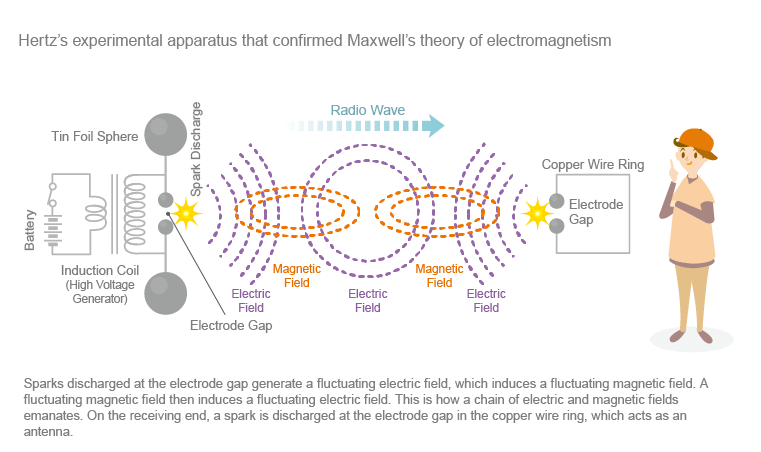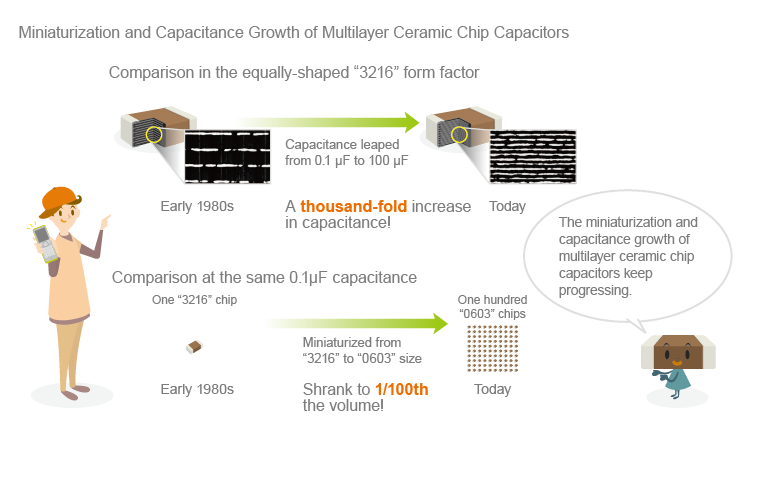Understanding the Types and Roles of Capacitors through Five Articles | The World of Power Capacitors
Part 3: The Capacitor is the Hidden Star of Electronic Circuits—Role #2: Blocking DC and Passing AC

In addition to storing electric charges, capacitors feature the important ability to block DC current while passing AC current, and are used in a variety of ways in electronic circuits. Most noises that cause electronic devices to malfunction are high-frequency AC components found in currents. Capacitors are indispensable to noise suppression.
Capacitors have a structure where the poles are separated by an insulator (air or a dielectric). We can understand that they block DC current, but why are they able to pass AC current?
- Can current flow through the dielectric (insulator) of a capacitor?

- Changes in electric fields are equivalent to the flow of current

- Capacitors pass AC currents in higher frequencies more easily

- The reason capacitors are used for noise suppression

- Diverse LC filters are formed by combining inductors and capacitors

- Coupling, bypass and decoupling capacitors

Can current flow through the dielectric (insulator) of a capacitor?
It is not difficult to understand how a capacitor blocks DC current. For example, if you connect a capacitor to a dry cell battery—a DC power source—current will flow momentarily but quickly stop. As soon as the power source fully charges the capacitor, DC current no longer flows through it. Because the capacitor’s electrode plates are separated by an insulator (air or a dielectric), no DC current can flow unless the insulation disintegrates. In other words, a capacitor blocks DC current. Why, then, does a capacitor allow AC power to pass?
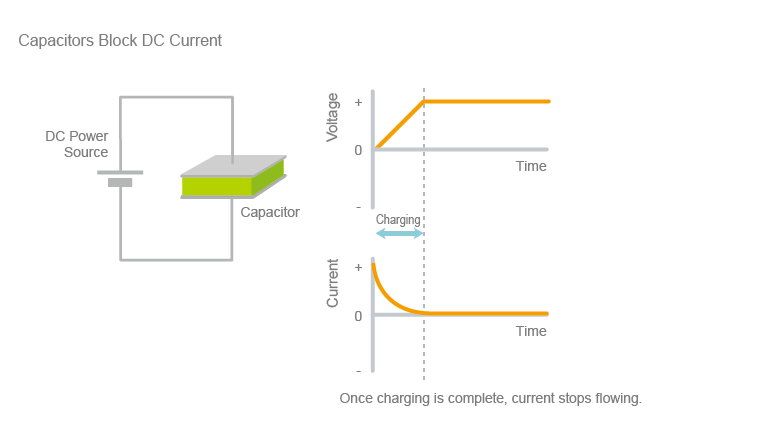
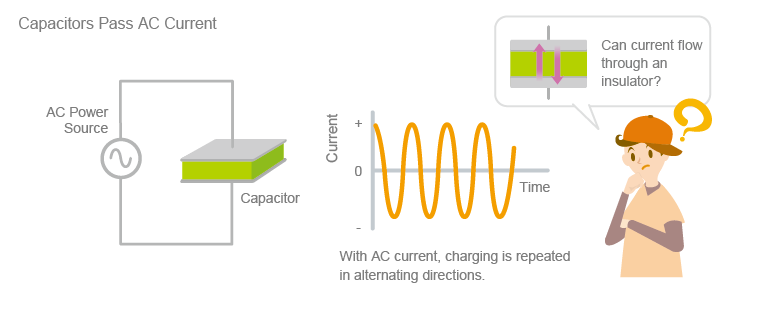
Changes in electric fields are equivalent to the flow of current
In an AC current, the polarity changes regularly between positive and negative. Capacitors are repeatedly charged and discharged as the current’s polarity alternates, allowing AC current to flow through.
Let’s explain this using the basic laws of electromagnetism. When an electric current flows through a conductor, magnetic flux lines are generated clockwise to the direction of the current (the magnetic effect of electric current, discovered by Hans Ørsted). When the current’s direction is reversed, so is the direction of the flux lines.
So what happens when you connect a capacitor to an AC power source? As the direction of the current alternates, the direction of the electric field generated between the capacitor’s electrode plates also alternates. Oscillating electric fields generate oscillating magnetic fields, which is considered equivalent to the flow of electric current (James Maxwell’s theories of electromagnetism). It is therefore acceptable to construe AC current to be “flowing” inside the capacitor’s dielectric—although the dielectric is an insulator. This is how we explain the ability of capacitors to “conduct” AC current. However, this does not mean that current flows through the dielectric of a capacitor in the same way it flows through a conductor. To be exact, current flowing through a conductor is referred to as conducted current, while current flowing through an insulator is known as displacement current.
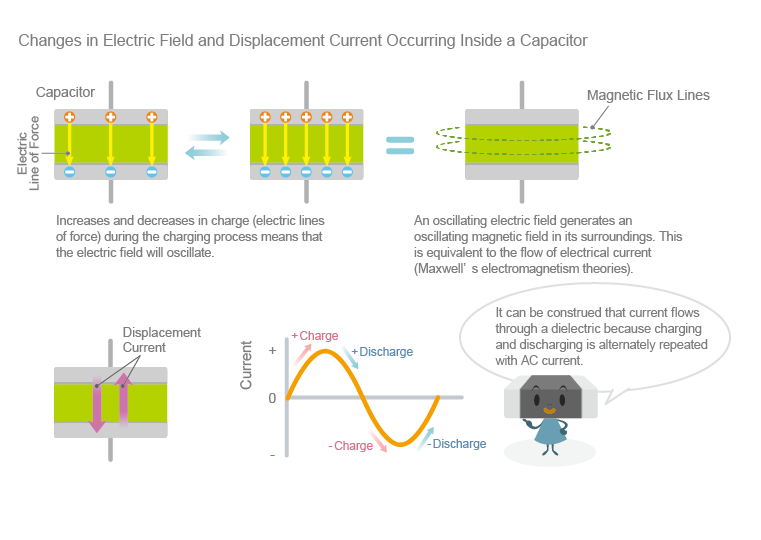
Capacitors pass AC currents in higher frequencies more easily
Voltage (V) = Resistance (R) x Current (I). This is the famous Ohm’s law that we learn during science class in school. The law also applies to AC current flowing through a resistor. A capacitor also behaves like a resistor against AC current—a property known as capacitive reactance. However, a capacitor does not conduct all forms of AC current in the same way: its capacitive reactance is inversely proportional to the frequency of the AC current.
Capacitive reactance (Xc) is expressed as 1 / (2πfC), where f is the AC frequency and C is the capacitance of the capacitor. In other words, the higher the frequency and the larger the capacitance, the smaller the resistance (capacitive reactance) to AC current, and therefore the easier it is for current to pass.
The reason capacitors are used for noise suppression
Capacitors used for noise suppression take advantage of the property of passing higher-frequency AC currents more easily. Because noise is largely a collection of AC currents in high frequencies, a component that smoothly passes high frequencies can be utilized to reduce noise.
For example, when a fluorescent light fixture is turned on, noise may be heard on the radio. A high voltage (called a kick voltage) is required to illuminate a fluorescent lamp; it is created by the ballast’s coil and the repetitive opening and closing of the glow switch starter’s contacts. When the light is turned on and the starter begins to open and close, current flows and stops rapidly. These abrupt changes include high-frequency currents, which interfere with radio reception and cause audible noises. To alleviate the problem, a capacitor is connected in parallel to the starter to suppress noise. The capacitor’s inherent property directs noises to flow through the capacitor, reducing their external leakage.
However, there are many different types of noise, and capacitors cannot eliminate them all. Especially in circuits that operate with small currents and low voltages, noise can cause malfunctions or even damage. This is why an intricate array of noise countermeasures is taken, like utilizing noise filters combined with inductors, and electromagnetic shielding.
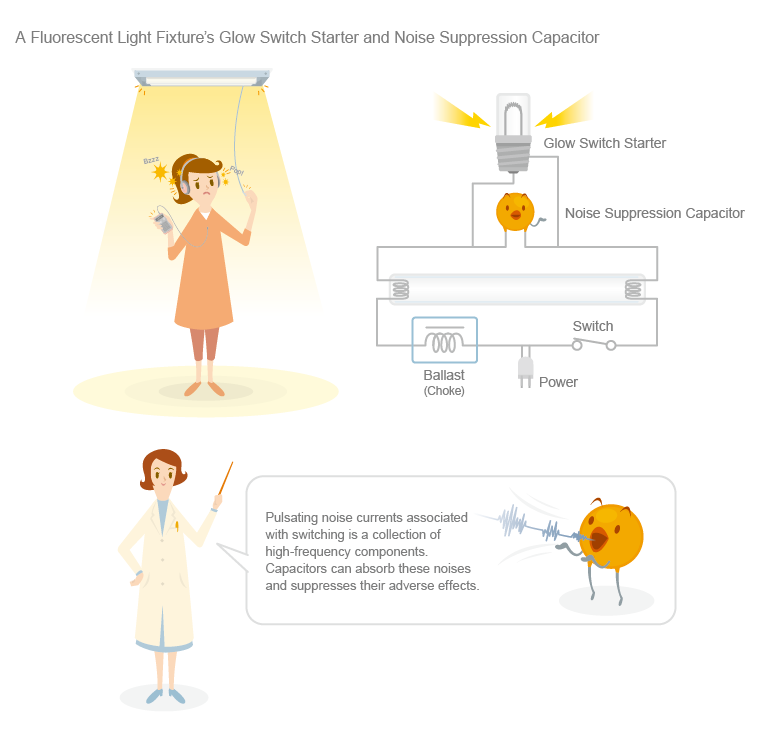
Diverse LC filters are formed by combining inductors and capacitors
In electronic circuits, the property of capacitors to pass higher-frequency AC currents more smoothly is utilized in a multitude of ways. The most basic form is a circuit that combines a capacitor and a resistor.
In a circuit, when a capacitor is connected in parallel and a resistor in series, higher-frequency AC components flow into ground (earth). This behavior is essentially a low-pass filter (LPF) that cuts high-frequency components and allows low-frequency components to pass (see left side of figure below).
Conversely, when a capacitor is connected in series and a resistor in parallel, DC components are blocked, while higher-frequency AC components are passed through the circuit—effectively creating a high-pass filter (HPF), which cuts low-frequency components and passes higher frequencies (see right side of figure below).
In actual LPFs and HPFs, inductors (coils) are used instead of resistors to improve the frequency characteristics and achieve steeper response curves. They are collectively called LC filters—including band-pass filters (BPFs) that pass only specific frequency ranges—because they all combine inductors (denoted as L) and capacitors (C).
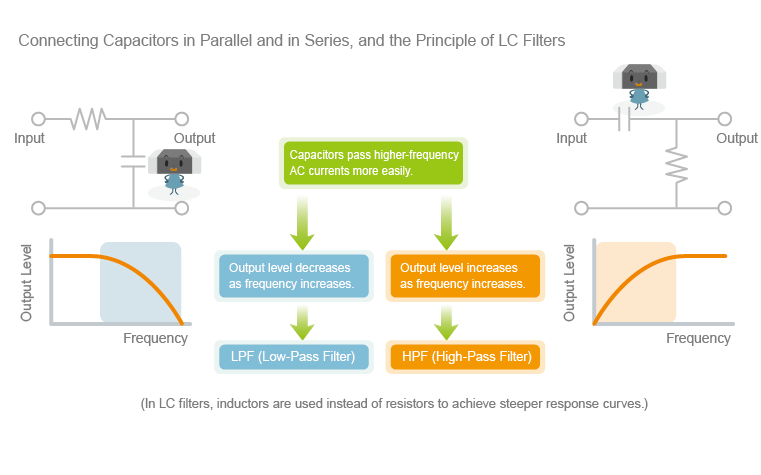
Coupling, bypass and decoupling capacitors
In circuits that include ICs, capacitors positioned as coupling capacitors, bypass capacitors and decoupling capacitors are widely used.
The figure below shows an example of a common analog circuit where a current is amplified by a transistor—a weak signal current (AC) is superimposed on a DC voltage and fed into the next stage. However, because individual circuit blocks have different operating conditions, it is necessary to pass only the signal current while blocking the DC current—which is why a capacitor is used. This usage is called a coupling capacitor.
A bypass capacitor is used to direct (bypass) noise and other AC components to ground. In the diagram below, it is placed between power and ground. It bypasses noise superimposed on the DC power source and supplies a stable voltage to the transistor. If the voltage supplied to the IC fluctuates, the circuit’s behavior can become unstable. To prevent this, a capacitor is placed between the IC’s power pin and ground (see figure below). This is also an example of a bypass capacitor. It is also referred to as a decoupling capacitor because it separates AC from DC current, allowing only DC to pass. Sometimes, to improve characteristics over a wide frequency range, a high-capacitance capacitor is connected in parallel with a multilayer ceramic chip capacitor with robust high-frequency characteristics.
Beginners may find the terminology in this article difficult to grapple with, but there is no need to feel inundated. They are all applications of the same basic property of a capacitor: blocking DC current while allowing AC current to pass—and more easily at higher frequencies.
That said, in high-frequency ranges, the resistive and inductive (coil) components of wiring and internal electrodes become conspicuous, and the capacitor by itself begins to behave like an LC filter. In other words, the capacitor reveals a different face in the high-frequency domain—a subject we will explore in the next article.
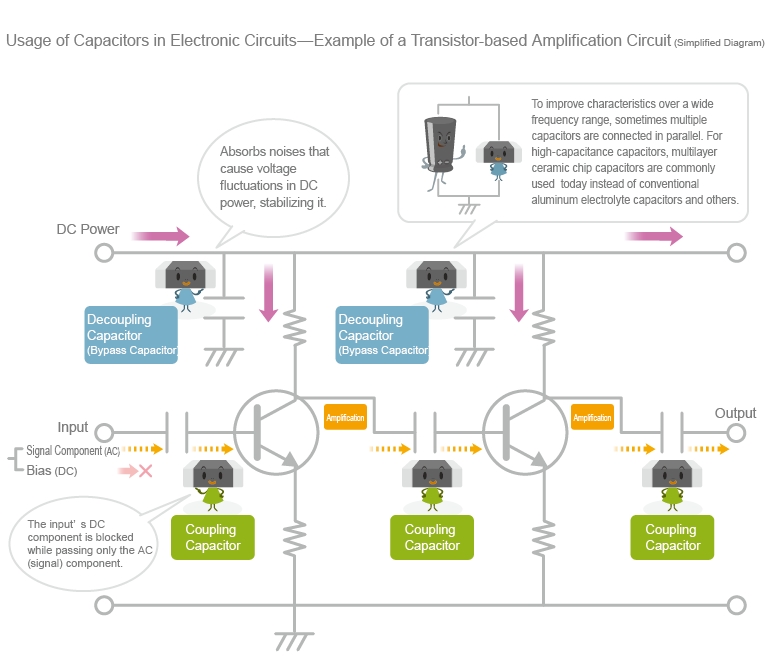
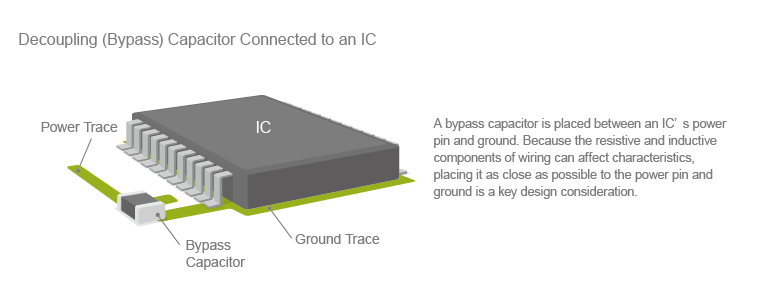
TDK is a comprehensive electronic components manufacturer leading the world in magnetic technology



